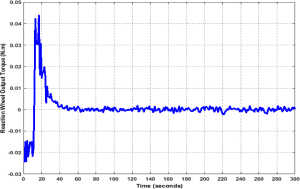What is a Reaction Wheel?
A reaction wheel is a key device used in spacecraft for attitude control. It operates by spinning at varying speeds to create torque, which in turn alters the orientation of the satellite. These wheels are part of a system known as momentum wheels, and they help maintain stability without the need for fuel or external mechanical forces, making them ideal for long-duration space missions.

The Role of Reaction Wheel Dynamics
The dynamics of a reaction wheel system are based on principles of angular momentum and conservation of momentum. When a reaction wheel spins, it generates torque that affects the spacecraft’s orientation. By adjusting the speed of the wheel, the spacecraft can be rotated or stabilized. The core dynamics of this system are essential for accurate attitude control, ensuring the spacecraft maintains the correct orientation during its mission.
1. Principles of Angular Momentum
The core principle behind reaction wheels is angular momentum. According to the conservation of angular momentum, the total angular momentum of a closed system remains constant unless acted upon by an external torque. When a reaction wheel spins in one direction, the satellite will experience a counteracting force, adjusting its attitude.
2. Attitude Control Using Reaction Wheels
In satellite operations, precise attitude control is crucial for tasks such as imaging, communication, and Earth observation. Reaction wheels are used to fine-tune the orientation of the spacecraft, providing the necessary adjustments to keep instruments pointed in the right direction. This control is achieved by varying the speed of the reaction wheel, with the spacecraft’s attitude changing accordingly.
Key Advantages of Reaction Wheel Systems
Reaction wheel systems offer several key advantages over other attitude control mechanisms such as magnetic torquers or control moment gyroscopes.
1. High Precision and Fine Control
Reaction wheels provide fine control of the spacecraft’s attitude, allowing for precise adjustments. This makes them ideal for missions that require high accuracy, such as telescopic observations or detailed Earth monitoring.
2. No External Forces Required
Unlike systems that rely on external forces like magnetic fields, reaction wheels do not require interaction with the environment to function. This makes them highly effective in the vacuum of space, where there are no air currents or other forces to rely on.
3. Long-Term Stability
Because reaction wheels do not consume fuel like traditional propulsion systems, they provide long-term stability for satellites. This is especially beneficial for long-duration missions, such as those in deep space.
Challenges in Reaction Wheel Technology
Despite their many advantages, reaction wheels face some challenges that need to be addressed for more efficient space missions.
1. Wear and Tear
One of the primary challenges with reaction wheels is the wear and tear of the wheel’s bearings. Over time, friction can cause degradation, leading to a loss of performance and, in some cases, failure of the wheel. This can limit the lifespan of a satellite or spacecraft.
2. Momentum Management
As reaction wheels are used to control the satellite’s attitude, they accumulate momentum. Eventually, the wheel reaches its maximum capacity, at which point momentum dumping techniques, such as using magnetic torquers or thrusters, are required to reset the system.
3. Redundancy and Reliability
To mitigate the risk of failure, spacecraft often use multiple reaction wheels in a redundant configuration. This ensures that if one wheel fails, the system can continue to function with the remaining wheels.
Innovations in Reaction Wheel Systems
Recent innovations in reaction wheel technology focus on improving durability, efficiency, and overall performance. New materials and designs aim to reduce friction, increase the lifespan of the wheels, and enhance their performance in extreme conditions. Additionally, advanced software algorithms are being developed to optimize wheel operation and reduce the likelihood of failure.
Interested in learning more about reaction wheel systems and their advancements?
Click here to explore the latest trends and technologies in reaction wheel dynamics.
